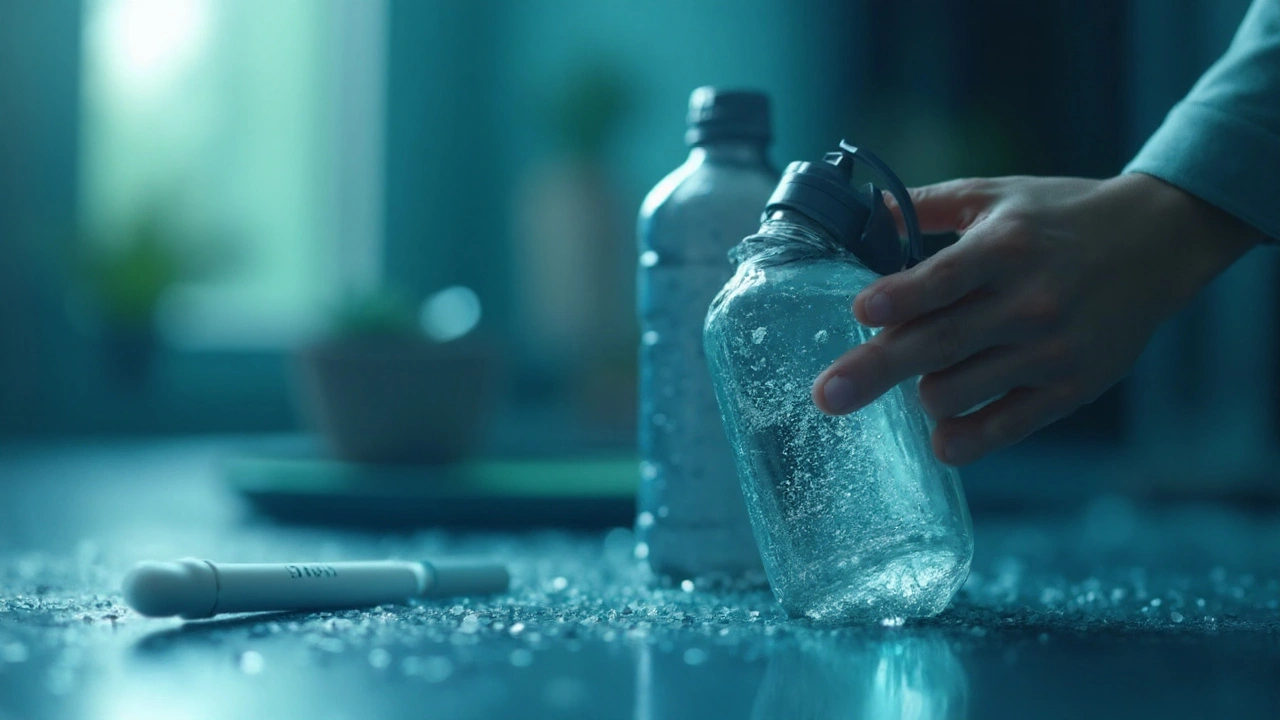Why Increased Thirst Often Comes with Frequent Urination - Understanding the Link
 Aug, 12 2025
Aug, 12 2025
Polydipsia‑Polyuria Relationship is a physiological link where excessive thirst (polydipsia) and increased urine output (polyuria) arise together due to shared hormonal, metabolic, or renal factors. Understanding this connection helps pinpoint everything from diabetes to simple dehydration.
Quick Take
- Both thirst and urination are controlled mainly by the body’s water‑balance system.
- High blood sugar, low ADH, or kidney‑concentrating defects can trigger both symptoms.
- Distinguishing medical causes from lifestyle factors avoids unnecessary worry.
- Simple tests (blood glucose, urine specific gravity) often reveal the root cause.
- Treating the underlying issue usually resolves both thirst and frequent peeing.
How the Body Regulates Water
Three key players keep water levels in check:
- The antidiuretic hormone (ADH) (also called vasopressin) tells kidneys to re‑absorb water, reducing urine volume.
- The renal concentrating ability refers to the kidney’s capacity to create concentrated urine determines how much water is saved.
- The osmotic balance is maintained by electrolytes like sodium and potassium, driving thirst signals.
When any of these systems falter, the brain signals thirst while the kidneys dump more fluid, creating the classic duo of increased thirst and frequent urination.
Medical Conditions That Pair Thirst with Peeing
Below are the most common health issues where the polydipsia‑polyuria link is a red flag.
| Condition | Typical Blood Glucose (mmol/L) | Primary Mechanism for Thirst | Average Urine Output (L/24h) |
|---|---|---|---|
| Type 1 Diabetes Mellitus | >30 (hyperglycaemic) | Osmotic pull from excess glucose | 5-8 |
| Type 2 Diabetes Mellitus | 7-15 (often elevated) | Glucose‑induced osmotic load | 3-6 |
| Psychogenic Polydipsia | Normal | Behavioral compulsion to drink | 4-7 |
| Diabetes Insipidus (central) | Normal | ADH deficiency | 6-10 |
| Chronic Heart Failure | Normal to mildly high | Reduced perfusion triggers thirst | 2-4 (often nocturnal) |
Notice how blood glucose spikes are exclusive to diabetes, whereas central diabetes insipidus stems from a hormone gap. The table helps clinicians narrow down causes quickly.
Deep Dive into the Top Five Triggers
1. Diabetes Mellitus - When blood glucose climbs above the renal threshold (≈11mmol/L), glucose spills into urine, pulling water with it (osmotic diuresis). The resulting fluid loss tricks the brain into a thirst surge.
2. Diabetes Insipidus - Either a shortage of ADH (central) or kidney resistance (nephrogenic) means the collecting ducts stay “leaky.” The kidneys can’t concentrate urine, so you lose up to 20L a day and feel a relentless urge to drink.
3. Psychogenic Polydipsia - Often seen in psychiatric patients, the habit of drinking large volumes overwhelms the kidneys. Even though blood glucose stays normal, the sheer volume forces frequent voiding.
4. Dehydration - Heat, vigorous exercise, or fluid‑restricting illnesses raise plasma osmolality. Sensors in the hypothalamus fire the thirst reflex, and any residual fluid quickly becomes urine as the body tries to clear waste.
5. Medications & Substances - Diuretics, caffeine, and some antihypertensives boost renal output. The extra loss triggers compensatory thirst, especially if the drug dose is high.

Diagnostic Steps to Uncover the Cause
When a patient presents with both symptoms, a systematic work‑up saves time.
- Measure fasting blood glucose and HbA1c - values >7mmol/L point toward diabetes mellitus.
- Check serum sodium and osmolality - hypernatremia (>145mmol/L) suggests water loss without adequate intake.
- Obtain urine specific gravity - a low value (<1.005) indicates dilute urine, typical of diabetes insipidus or psychogenic polydipsia.
- Perform a water‑deprivation test - distinguishes central from nephrogenic diabetes insipidus based on response to synthetic ADH.
- Review medication list - note any diuretics, lithium, or glucocorticoids.
- Evaluate cardiac and renal function - echocardiogram or eGFR can reveal heart failure or chronic kidney disease, both of which affect fluid balance.
These steps create a clear picture of whether the problem is metabolic, hormonal, renal, or behavioural.
Management Strategies Tailored to the Underlying Issue
Targeted treatment works best. Below are concise plans for each major cause.
- Diabetes Mellitus: Lifestyle changes, oral hypoglycemics, or insulin therapy bring glucose back under control, eliminating osmotic diuresis.
- Central Diabetes Insipidus: Desmopressin nasal spray or tablet replaces missing ADH, reducing urine volume dramatically.
- Nephrogenic Diabetes Insipidus: Low‑salt diet, thiazide diuretics, and possibly NSAIDs improve kidney concentrating ability.
- Psychogenic Polydipsia: Behavioural therapy, water‑restriction schedules, and monitoring electrolyte levels prevent hyponatraemia.
- Dehydration: Re‑hydration with oral rehydration solutions (ORS) or IV crystalloids for severe cases restores osmolality.
- Medication‑Induced: Adjust dose or switch to an alternative; counsel patients on fluid timing.
In every case, monitoring urine output and thirst perception over a week helps gauge success.
Related Concepts and How They Interact
Understanding the polydipsia‑polyuria link opens doors to other health topics:
- Electrolyte balance the fine‑tuned relationship between sodium, potassium, and water movement - disorders here can mimic thirst without affecting glucose.
- Renin‑angiotensin‑aldosterone system (RAAS) regulates blood pressure and fluid retention, influencing both thirst and urine output - over‑activation in heart failure often triggers nocturnal urination.
- Osmoreceptors sensory cells in the hypothalamus that detect plasma osmolality and drive thirst - damage here can blunt the thirst response, leading to dangerous dehydration.
Exploring these areas can help clinicians and readers alike appreciate why a simple symptom pair can signal a complex cascade.
Practical Tips for Everyday Monitoring
Even if you’re not a patient, keeping an eye on the thirst‑pee relationship can flag early problems.
- Log daily fluid intake and urine frequency for a week - note any upward trends.
- Check urine colour - pale straw suggests good hydration; clear may indicate over‑hydration; dark amber may signal dehydration.
- Watch for night‑time trips to the bathroom - more than once per night is a red flag.
- If you have a chronic condition (e.g., diabetes), schedule quarterly labs for glucose and kidney function.
- Seek medical advice if thirst spikes suddenly, especially with dry mouth, unexplained weight loss, or fatigue.
Simple awareness often catches issues before they become emergencies.

Frequently Asked Questions
Why do I feel thirsty right after I’ve been drinking a lot of water?
Your kidneys may be unable to concentrate urine fast enough, especially if you’ve taken a diuretic or have early‑stage diabetes insipidus. The excess fluid passes through quickly, leaving the body still signalling a need for more water.
Can high blood pressure cause frequent urination?
Yes. Hypertension often activates the RAAS system, prompting the kidneys to retain sodium and water during the day but excrete excess fluid at night, leading to nocturnal polyuria.
Is it normal to wake up twice a night to pee?
Occasional trips are common, but more than once per night consistently may indicate an underlying condition such as diabetes, heart failure, or a sleep‑related bladder issue. Track the pattern and discuss it with a doctor.
How does caffeine affect thirst and urination?
Caffeine is a mild diuretic; it increases renal blood flow and reduces ADH effectiveness, so you may notice a quick surge in urine volume followed by a short‑term increase in thirst as the body seeks to replace lost water.
Can I self‑diagnose the cause of my symptoms?
Self‑assessment can highlight red flags, but a proper diagnosis requires lab tests (blood glucose, serum sodium, urine osmolality) and often a specialist’s evaluation. Don’t rely solely on internet information for treatment decisions.
Casey Lyn Keller
September 22, 2025 AT 10:30The body's water balance system is way more fragile than doctors let on. I've seen people drink gallons and still be dehydrated because their kidneys are just giving up. No one talks about how much processed food messes with osmotic balance. It's not just diabetes or ADH-it's the sodium overload from chips and soda that nobody admits is the real culprit.
May .
September 22, 2025 AT 17:44Been there drank the water literally
Sara Larson
September 24, 2025 AT 02:18This is such a clear breakdown 🙌 I love how you laid out the mechanisms without jargon overload. If you're reading this and suddenly noticing you're peeing every hour and chugging water like it's your job-don't ignore it. Get that glucose test. Your future self will thank you. You got this 💪
Josh Bilskemper
September 25, 2025 AT 13:22Table is decent but you missed the elephant in the room-most people with polydipsia-polyuria are just bad at hydration habits and mistake thirst for hunger. The real issue is cultural ignorance not physiology. Glucose tests are overrated when 80% of cases are just people drinking too much kombucha and blaming their kidneys
Storz Vonderheide
September 25, 2025 AT 16:16Really appreciate this breakdown. I'm from a country where diabetes screening isn't routine and I've seen too many people suffer for months before getting tested. The key takeaway here isn't just the science-it's the urgency to act. If you're thirsty all the time and peeing nonstop, don't wait for a doctor to notice. Advocate for yourself. Ask for the glucose test. Ask for urine specific gravity. This isn't anxiety-it's your body screaming for attention. And if you're reading this and you're a parent or caregiver-watch for this in kids too. It's not just "they're drinking too much juice". It could be type 1. Early detection saves lives.